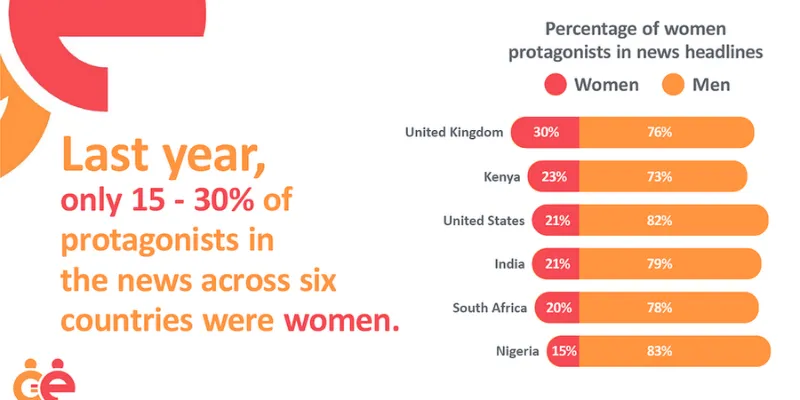Global news media lacks women’s perspective: Report
In India, only 21 percent of news coverage last year featured women as protagonists. Across the six countries surveyed, the report urges the critical need to unmute women across levels producing and consuming news.
Women’s representation has flatlined, if not reversed in the 21st century, finds a report commissioned by the Bill & Melinda Gates Foundation.
The marginalisation reflects across areas of news media with the underrepresentation of women in newsroom leadership, lack of coverage on gender equality issues, and men dominating content as quoted experts and sources.
The report, titled The Missing Perspectives of Women in News, examined women’s representation in newsrooms, newsgathering, and news coverage in India, Kenya, Nigeria, South Africa, the UK, and the US.
Across these countries, gender equality issues accounted for less than one percent of the coverage.
In 2019, only 15 to 30 percent of protagonists in the news were women and a mere 14 to 29 percent of the quoted voice in online news were attributed to women.
In India, 21 percent of the news coverage featured female protagonists while as many as 79 percent of stories were reported with men in focus.

(Source: The Missing Perspective of Women in News / Illustration credit: International Women's Media Foundation)
The issue of gender parity in news media became particularly stark this year as coverage on COVID-19 was largely dominated by men’s perspective, although the pandemic has disproportionately impacted women economically, socially, and politically.
In COVID-19-related news, a woman’s voice is drowned out by three to five men. In fact, women are presented less as authoritative experts but as victims and those affected by the virus.
More staggering data
For a decade between 2005 and 2015, less than one in five experts globally in the news were women. Not a lot has changed as data reveals equally grim state of affairs.
In today’s India, men are six times more likely to be quoted in online news than women. Men’s quotes are likely to be featured twice as frequently as women in the UK, three times more frequently in South Africa and in the US, four times more frequently in Kenya, and five times more in Nigeria.
Male-dominated culture is one of the reasons that women’s portrayal has not increased for decades. The universal patriarchal leads to men leading reportage on ‘agenda-setting news beats such as politics and economy’ while women are assigned ‘lower profile news beats such as arts, education and entertainment.’
According to the study, women consume less news than men because it is produced mainly by men, and does not cater to women’s perspectives or needs.
“If women are to be empowered through their news consumption, it is important to understand their news needs, news consumption and their interaction with the new digital technologies and social media,” the report states.
Spotlighting gender equality

Gender blindness amongst the public was identified as a major challenge in advancing gender equality in the news. It is hard to fix something that is not seen as broken, the report says. Observing international and national women’s days are putting focus on gender inequality through increased coverage.
“As I was writing this report, at times I was stunned not only by the extent to which men are prioritised at the expense of women globally, but also by how normalized gender inequalities and pro-male biases are in societies among both men and women,” wrote Luba Kassova, who authored the report.
However, the study also found that youth across these countries are more likely to support gender equality than the older generation. It recommends engaging and sensitising students in primary and secondary schools and especially journalism students in universities can lead to a promising future.
The study is also touted as a call to action for journalists, governing boards, and leadership teams to challenge the status quo. Some more recommendations include, being mindful of wording while reporting, ensuring diversity through effective policies that tackles pay gap and prioritise childcare, drawing specific goals related to gender inequality, among others.









